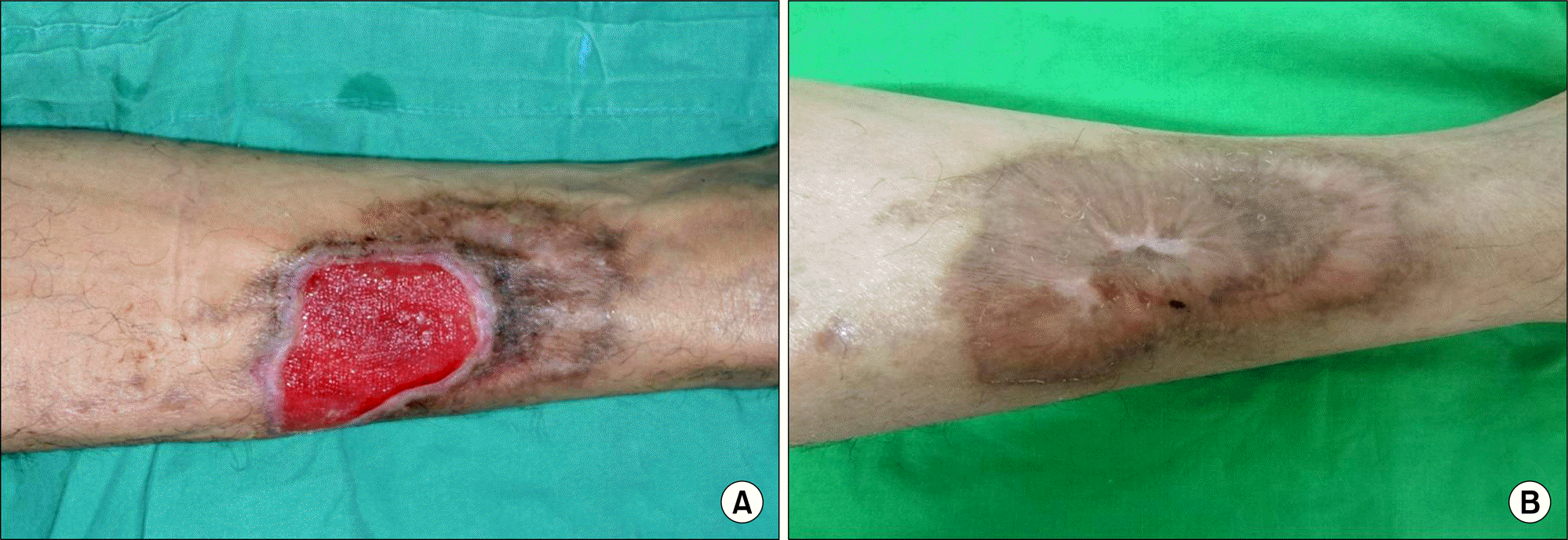This article has been corrected. See "A Case of Propylthiouracil induced Antineutrophil Cytoplasm Antibody Positive Pyoderma Gangrenosum" in Volume 21 on page 224.
Abstract
Pyoderma gangrenosum (PG) is a rare disease that causes chronic skin ulcers, and it has recently been known to be related to changes in the immune system such as dysfunction of neutrophils. Over 50% of patients with PG have an underlying systemic disease, and rarely are there various medicines causing the disease, including iodide, bromide, and isotretinoin. A 49-year-old man had recurrent skin ulcers in his lower extremities. He had a history of taking propylthiouracil (PTU) for 10 years as a treatment for Graves' disease. Here, we describe a case of PTU-induced ANCA positive PG in a patient with hyperthyroidism, who has been improved after the cessation of PTU.
REFERENCES
1. Brunsting LA, Goeckerman WH, O'LEARY PA. Clinical and experimental observations in five cases occurring in adults. Arch Derm Syphilol. 1930; 22:655–80.
2. Crowson AN, Mihm MC Jr, Magro C. Pyoderma gangrenosum: a review. J Cutan Pathol. 2003; 30:97–107.
4. Darben T, Savige J, Prentice R, Paspaliaris B, Chick J. Pyoderma gangrenosum with secondary pyarthrosis following propylthiouracil. Australas J Dermatol. 1999; 40:144–6.

5. Lee SD, Lee JH, Kim KM, Yu DS, Park CJ, Park YM, et al. Pyoderma Gangrenosum: A Clinical Study. Korean J Dermatol. 2008; 46:1028–35.
6. Kitahara T, Hiromura K, Maezawa A, Ono K, Narabara N, Yano S, et al. Case of propylthiouracil-induced vasculitis associated with anti-neutrophil cytoplasmic antibody (ANCA); review of literature. Clin Nephrol. 1997; 47:336–40.
7. Sato H, Hattori M, Fujieda M, Sugihara S, Inomata H, Hoshi M, et al. High prevalence of antineutrophil cytoplasmic antibody positivity in childhood onset Graves' disease treated with propylthiouracil. J Clin Endocrinol Metab. 2000; 85:4270–3.

8. Jacobs EM, Hartkamp A, Kaasjager HA. PTU-associated cutaneous vasculitis with ANCA anti-MPO and anti-PR3 antibodies. Neth J Med. 2003; 61:296–9.
9. Hong SB, Lee MH. A case of propylthiouracil-induced pyoderma gangrenosum associated with antineutrophil cytoplasmic antibody. Dermatology. 2004; 208:339–41.

10. Seo JW, Son HH, Choi JH, Lee SK. A Case of p-ANCA-Positive Propylthiouracil-Induced Pyoderma Gangrenosum. Ann Dermatol. 2010; 22:48–50.

11. Hoffman MD. Pyoderma gangrenosum associated with c-ANCA (h-lamp-2). Int J Dermatol. 2001; 40:135–7.

12. García-Morales I, Herrera-Saval A, Camacho F. Pyoderma gangrenosum over a saphenectomy scar in a cANCA-positive patient with diverticulitis. Actas Dermosifiliogr. 2005; 96:258–60.
13. Choi HK, Merkel PA, Tervaert JW, Black RM, McCluskey RT, Niles JL. Alternating antineutrophil cytoplasmic antibody specificity: drug-induced vasculitis in a patient with Wegener's granulomatosis. Arthritis Rheum. 1999; 42:384–8.

14. Gunton JE, Stiel J, Clifton-Bligh P, Wilmshurst E, McElduff A. Prevalence of positive anti-neutrophil cytoplasmic antibody (ANCA) in patients receiving anti-thyroid medication. Eur J Endocrinol. 2000; 142:587–90.

15. Koca E, Duman AE, Cetiner D, Buyukasik Y, Haznedaroglu IC, Uner A, et al. Successful treatment of myelodysplastic syndrome-induced pyoderma gangrenosum. Neth J Med. 2006; 64:422–4.




 PDF
PDF ePub
ePub Citation
Citation Print
Print




 XML Download
XML Download